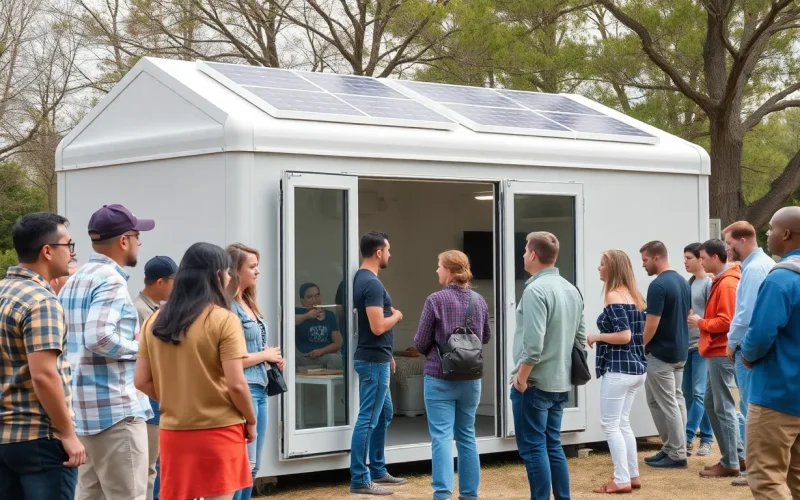Table of Contents
ToggleWhen disaster strikes, the last thing anyone wants to worry about is where to find shelter. Enter shelter tech, the superhero of emergency preparedness. This innovative field combines cutting-edge technology with practical solutions to ensure safety during crises. From portable shelters that pop up faster than you can say “natural disaster” to smart materials that adapt to changing conditions, it’s a game-changer in the world of emergency response.
Imagine a world where getting caught in a storm doesn’t mean huddling under a flimsy tarp or braving the elements. With shelter tech, that dream becomes a reality. It’s not just about surviving; it’s about thriving even in the most challenging situations. So buckle up and get ready to explore how these advancements are transforming emergency shelters into high-tech havens that keep people safe and sound when it matters most.
Overview of Shelter Tech for Emergencies
Shelter tech encompasses a range of innovative solutions designed to address emergency situations effectively. These solutions prioritize rapid deployment, allowing first responders and individuals to set up portable shelters within minutes. Advanced materials play a significant role in these technologies, often exhibiting self-heating or self-cooling properties to maintain comfortable indoor temperatures.
Smart features integrated into these shelters enhance safety. For example, energy-efficient systems provide light and power, while built-in communication tools keep occupants connected. These elements improve not only survival rates but also the overall experience during crises.
Various organizations have developed and tested shelter units under extreme conditions, demonstrating their effectiveness and reliability. Portable designs enable easy transport, making them suitable for various terrains, from urban environments to remote areas. Many models also contain additional components such as water filtration systems and hygiene facilities.
The versatility of shelter tech allows it to adapt to various emergencies, including natural disasters, refugee situations, and pandemics. Innovations in design aim to provide higher resilience against harsh weather conditions, promoting further advancements in this evolving field. Outstanding examples of this tech highlight the integration of renewable energy sources, thus reducing reliance on external support.
Shelter tech continues to expand, integrating emerging technologies like 3D printing and autonomous systems. These advancements promise to enhance efficiency and adaptability, further helping communities during emergencies. With ongoing developments, the future of shelter tech holds great potential for safeguarding lives and promoting recovery.
Types of Shelter Technologies

Shelter tech features various innovative solutions tailored for emergency preparedness. These technologies provide essential support during crises, focusing on rapid deployment and adaptability.
Portable Shelters
Portable shelters play a crucial role in emergency situations. Designed for quick setup, these units can accommodate individuals and families efficiently. They often feature lightweight materials for easy transportation. Self-heating or cooling systems maintain comfortable conditions, regardless of external weather. Many portable shelters include solar panels, providing power for essential devices. Testing in extreme climates shows their durability and effectiveness. Organizations deploy these shelters in natural disasters and refugee crises, ensuring safety and support during critical times.
Modular Housing Solutions
Modular housing solutions offer flexibility and scalability in emergency response. These structures consist of pre-fabricated units that can connect seamlessly, creating larger living spaces. Each module features essential amenities, including bathrooms and kitchens, enhancing livability. Efficient designs promote energy conservation through insulation and renewable energy sources. Various organizations use modular housing in post-disaster recovery, aiding families displaced by emergencies. Their adaptability makes them ideal for diverse environments and emergencies. Implementing such solutions helps communities recover and rebuild effectively.
Key Features of Effective Shelter Tech
Effective shelter tech features rapid deployment and disaster resilience, ensuring safety in emergencies.
Rapid Deployment
Rapid deployment is crucial for shelter tech. Some designs utilize lightweight materials for easy transport and setup. Others integrate fast-assembly features, allowing users to erect shelters within minutes. Swift installation significantly enhances emergency response, especially during natural disasters. Technology ensures shelters can be quickly accessible, making readiness a top priority. Many models include portable components, facilitating movement across various terrains. Speedy deployment reduces risk for individuals in precarious situations, ensuring they gain immediate refuge.
Disaster Resilience
Disaster resilience is another vital feature of effective shelter tech. Modern shelters are built to withstand extreme weather conditions, ensuring protection during hurricanes, floods, and earthquakes. Advanced materials are employed, promoting durability and stability in adverse conditions. Innovations like modular designs allow for easy expansion and adaptation as needs evolve. Built-in safety features, such as secure anchorage systems, increase stability and security. Testing under extreme conditions demonstrates their reliability and effectiveness across different environments. Overall, these resilient designs enhance the overall experience for those impacted by crises.
Innovations in Shelter Tech
Innovations in shelter tech focus on enhancing emergency preparedness and response. New technologies play a key role in improving functionality and comfort.
Smart Technology Integration
Smart technology enhances shelter effectiveness during emergencies. Systems equipped with sensors monitor conditions, allowing real-time adjustments for optimal protection. Energy-efficient systems control lighting and temperature, promoting comfort without excessive energy consumption. Built-in communication tools connect occupants with emergency services, ensuring critical information flows smoothly. These advanced features significantly improve the overall experience, making shelters safer and more functional during crises.
Sustainable Materials
Sustainable materials form the backbone of modern shelter tech, prioritizing environmental impact without sacrificing durability. Innovative composites and biodegradable options help reduce waste while maintaining structural integrity. Renewable energy elements, like solar panels, reduce reliance on non-renewable resources. These materials withstand harsh conditions, ensuring long-lasting performance through various scenarios. Each time a shelter uses sustainable materials, it supports eco-friendly practices and fosters resilience in rebuilding efforts.
Challenges and Limitations
Shelter tech faces several challenges that impact its effectiveness in emergencies. Resource availability often limits the deployment of advanced materials and technologies. High production costs can deter organizations from adopting these innovations, reducing accessibility.
Environmental factors also play a significant role. Extreme weather conditions can compromise shelter stability, even with advanced designs. Transportation difficulties might arise when relocating portable shelters to areas in need, leading to delays in emergency responses.
User acceptance is another issue. Individuals may resist adopting newer technologies due to unfamiliarity or misconceptions about their effectiveness. Additionally, logistical coordination among various agencies can result in conflicts or delays, affecting timely shelter distribution.
Implementation presents further challenges. Training personnel to operate and maintain sophisticated shelter technologies requires dedicated resources. Regular maintenance becomes essential to ensure reliability in high-stress situations, which can strain limited budgets.
Scalability poses a noteworthy concern. Expanding shelter tech solutions in large-scale disasters often demands more resources and infrastructure than available. Existing emergency protocols may not accommodate rapid adoption of innovative solutions, hindering overall system integration.
Lastly, addressing diverse needs remains crucial. Different populations may require specific accommodations based on geography or demographics. Tailoring shelter tech to fit varied cultural or social contexts proves challenging, affecting effectiveness across different emergency scenarios.
Overall, these challenges highlight the complexity of integrating shelter tech into emergency management, emphasizing the need for ongoing research and development to enhance solutions.
Shelter tech is revolutionizing emergency preparedness by merging technology with practical solutions. Its rapid deployment capabilities and smart features are essential for enhancing safety and comfort during crises. As the field continues to evolve, innovations in materials and design promise to improve resilience against various emergencies.
While challenges remain in resource availability and user acceptance, ongoing research and development will drive the future of shelter technology. By addressing these obstacles, communities can better prepare for disasters, ensuring that individuals have access to reliable and effective shelter solutions when they need them most. Embracing these advancements not only saves lives but also fosters a sense of security during difficult times.





